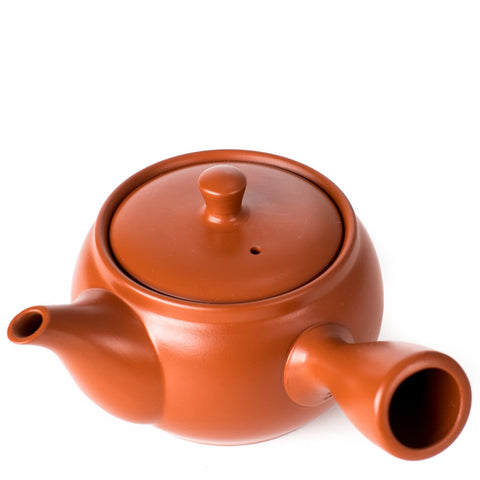In earlier times, drinking Japanese green tea was mainly associated with the upper classes – emperors, nobles, and samurai. Nowadays, households all throughout Japan enjoy Japanese green tea. People use the kyusu teapot all through Japan for the convenience of brewing Japanese green teas like sencha, genmaicha, and gyokuro. It is an iconic part of modern Japanese tea drinking culture.
What Is A Kyusu Teapot?
A kyusu is a traditional Japanese teapot made from clay. Its iconic characteristic is a single handle. Although in Japan people use the term "kyusu" to refer to all teapots, in the West we use it only for Japanese side-handled teapots. While potters make authentic Japanese teapots (kyusu) from high-quality clay, variations are not uncommon. Notably, porcelain and glass kyusu. Tea enthusiasts use porcelain ones for tea tastings.
A standard kyusu is slightly smaller than the average Western teapot. It can be anywhere from 100 - 300 ml. Although people use slightly larger ones for serving Japanese tea to guests.
A traditional kyusu has a handle at a 90-degree angle to the spout, though variations are not uncommon. Many believe that kyusu, compared to Western teapots of the same size, are much easier to handle and are more gentle on the wrists of the person serving tea.
One unique characteristic of a kyusu teapot is that during firing, potters almost always fire the lid together with the teapot. This makes finding a replacement for a broken lid nearly impossible.
While potters make the body from high-quality clay, they often line the inside with a fine-mesh strainer (either removable or built-in). This is crucial for brewing Japanese green tea because of how delicate the leaves are. Since we brew the tea directly in the teapot and decant every last drop of tea, to prevent over-steeping.
The History Of The Kyusu Teapot
Long ago, some merchants or perhaps monks brought the kyusu from China to Japan. However, it did indeed grow and evolve in Japan. With the gradual popularization of sencha over traditional matcha green tea, many households started owning their own kyusu teapots. They could now enjoy green tea leisurely at home, which was less common during the earlier era dominated by matcha.
The side-handled teapot design that inspired the Japanese kyusu originated in China during the Song Dynasty (960–1279).
Nowadays, most Japanese households own a kyusu for drinking Japanese green tea after dinner or throughout the day.
A poet and monk named Baisao popularized Sencha in the 18th century. People knew Baisao for leaving the temple and selling tea around Kyoto. His name translates as "old tea seller." Nowadays tea enthusiasts regard him as the first Senchado master.
Read more: History of Senchado - The Way of Sencha

The Making Of A Kyusu
Much like Yixing clay teapots, some kyusu teapots are unglazed or have a very thin coat of clear glaze. As such, potters place great importance on the type of clay used to craft the kyusu. Generally, they favor various clay types that are rich in iron and other natural minerals. While brewing the tea leaves directly in the kyusu teapot, the mineral-rich clay has a direct effect on how the tea will turn out. Usually, the clay softens the tea, removing unwanted bitter notes and making it sweet and smooth. Japanese green tea enthusiasts can often tell how the clay of a specific region of Japan will affect the tea's final taste and make their purchase based on this knowledge. The clay also brings out the tea's gentle aroma during brewing.
The two most popular types of clay for kyusu teapots are Banko from Yokkaichi, Mie prefecture, and Tokoname from Tokoname, Aichi prefecture.

The Yamada family from Tokoname is among Japan’s most renowned kyusu potter lineages. Yamada Jozan III (1924-2005) was named a Living National Treasure in 1998. Making handmade kyusu teapots is not an easy trade in pottery. Thus, kyusu artisans are highly respected throughout Japan.
Which Tea Can Be Brewed In A Kyusu Teapot?
It is most common to brew Japanese sencha green tea in a kyusu. However, kyusu are also ideal for brewing other Japanese green tea varieties. For example, genamicha, gyokuro, shincha, and hojicha. Because unglazed clay kyusu can absorb the tea’s aroma and oils, it’s best to dedicate each to one type of tea. For instance, dedicating your kyusu teapot only to Japanese green teas is a good start. Even roasted green teas like hojicha may impart a new flavor if you are used to brewing sencha in the kyusu.
How To Brew Tea Using A Japanese Kyusu Teapot
The following instructions are for sencha green tea. To brew other tea types, make sure to adjust the amount of tea leaves, water temperature, and brewing time.
- Prepare 0.5 grams of sencha for every 1 oz/30ml of water, place them directly in the kyusu
- Heat water in a tea kettle to 175℉ / 80℃
- Brew the sencha for 1 minute, for the first infusion
*Make sure to decant every last drop of tea to prevent the tea leaves from over-brewing - For the second infusion, steep the tea for 30 seconds
- Add 15 seconds to every subsequent infusion (Japanese green teas can usually be brewed 3 - 5 times)
